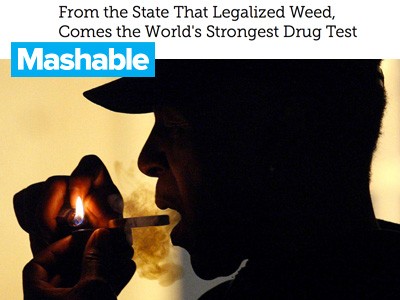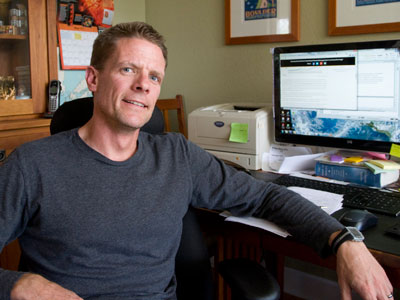Todd Neff is a Colorado-based freelance journalist who frequently writes for the University of Colorado Health Insider, a 2,000-circulation newsletter that provides information about the Denver-based University of Colorado Hospital’s operations for employees and faculty.
While writing for the UCH Insider, Neff happened across a story that fascinated him. CU Toxicology, a spinoff lab within the University of Colorado, had developed a drug test that could test for 112 compounds in 500 drugs in fewer than 10 minutes. The test, which also was less expensive than anything already on the market, had 20 times the sensitivity of the typical urine-based drug tests used to detect metabolites in THC, the active ingredient in marijuana.
With states such as Colorado legalizing recreational marijuana and others flirting with similar laws, Neff saw a story with a potential reach far further than the 2,000-circulation UCH Insider. And he saw a story with significant implications for businesses across the country.
Neff approached Mashable, a site for which he had previously written, and pitched an idea for an in-depth article on this new drug test.
At the beginning, Neff had no intention of being his own guinea pig, going “Gonzo” and putting himself to the test, but that’s what he did.
The CU Toxicology test is ultimately a new sort of medical tool, and one that allows those ordering urine tests to affordably plunge into the private habits and inner bodily workings of their targets like never before. Neff detailed his personal journey into ingesting and testing recreational marijuana in the Mashable Spotlight piece, ‘From the state that legalized weed, comes the world’s strongest drug test.’
Neff spoke with BusinessJournalism.com about approaching a big, multi-faceted issue; means of keeping an audience engaged through a 7,000-word, highly technical piece; and what he thinks could come of the drug testing industry. | You can follow Neff on Twitter @ToddNeff.
1.) What was the impetus for this piece?
It was actually an assignment for the UCH Insider. So I find myself in this converted optics factory, and I’m talking to this former venture capitalist and looking at these mass spectrometers, talking about urine tests, and I think, “This is crazy.”
The story was covered on Colorado Public Radio. The Denver Business Journal picked it up. We all published these articles that were all the equivalent of 650 to 800 words — 18-inch stories essentially that cover the basics. I say, “Hey, this is a really interesting test.”
What intrigued me was I looked at what I had done and 2,000 people read it. It was miniscule and I thought, “God, there is just so much more here.” (CU Toxicology lab director Uwe Christians) is a real interesting guy. I didn’t know how interesting the scientist was at the time. Here’s one of the great mass spectrometer minds in the world sitting in this office with a (Dr. Who) Dalek and Star Wars figurines everywhere.
I walk out the front door and here’s this Rolls Royce Corniche covered in dirt. You’ve never seen anything like this. And I thought that has got to be his car.
In an e-mail, I asked him about the Rolls Royce and he was so interested in talking about the car. It opened doors to follow-up questions about technical information. The fact I was interested in some of these other aspects of his life kind of endeared him to me.
I had written a story for Mashable (before). They had kind of cold-called me. I found a space-related piece – it was about Elon Musk and evacuated tube transport up in Longmont, Colo., and they were looking for a warm body. I liked working with (Mashable). And this (CU Toxicology story), everybody’s written a 1,000-word piece on it. I don’t want to write the same story again. Who will let me take this farther?
2.) Usually journalists take the role of outside observer, being careful not to taint the process or become the story. Why did you feel it was important to serve as the test subject in this article?
I didn’t initially plan on doing that. I put a blog post up that was a little bit of background on the story: Inhaling for the Narrative. I actually pasted the pitch letter into that.
There is no Gonzo at all in my mind at that point (when I made the pitch). I had already done some of the reporting and talked to five or six people, including the big interview. I thought to myself, “How am I going to tie together this Colorado legalization of recreational marijuana? What’s an elegant way to do that?”
When you work on these projects, they seep into your subconscious and you’re working on it all the time, and when I was in the shower, it was the “a-ha moment.”
“The fact I was interested
in some of these other
aspects of his life kind of
endeared him to me.”
I thought that I would start in the dispensary, buy some stuff — which is a unique thing — and then if I do that, what we can do is I’ll do the cheap test, the pee cup, the standard test and then maybe take the fancy CU toxicology test. So it clearly shows that long after I’m a negative that I passed the cheap test that I failed the fancy test — showing that this is the test we all need.
I smoke very rarely. I am not a pot smoker and so my body has zero THC in it and zero whatever other chemicals are in marijuana. There’s nothing in my body all the time.
I had a very fixed idea with how this thing was going to shape out.
3.) However, this didn’t shape out as you thought it might: Despite the initial Insta-Screen pee cup test registering a positive, CU’s mass spectrometer test results were negative for THC. What surprised you the most about this?
As a journalist, you’re pretty used to being surprised by things. You know most of the time – almost all the time – that changes as you report it. This was very unexpected, but it fit into the pattern of most features stories I’ve ever done. You never know what the story is until it’s done.
My initial thought was, “Why the heck? How could this be possible with this fantastic test?” My friend Louie was visiting from Australia. I had him take both the pee cup and the fancy CU toxicology also.
He also tested negative for THC, but Louie has rheumatoid arthritis and takes medications. The CU toxicology test found eight drugs (which he takes for pain management). When (the Mashable editors) cut that part, it was a cut I wish they hadn’t made. I felt that helped underscore the quality of this aspect of the CU toxicology project.
The reason I didn’t push back is: It was posted already and we had cut 700 words. Plus it’s their money; it’s their story.

Because I have three to four people — I don’t know how many people survived several cuts – who were extolling the virtues for this product. It’s clear that it works or otherwise they wouldn’t have talked about it that way. We learn as journalists that you go with it, or you drive yourself crazy.
4.) You judiciously sneaked in little nuggets of information and colorful details that provided some unique context and humor. What are some strategies you think other writers can use when approaching an article of this size and technical nature?
I don’t change much based on possible audience. When I write, I have a certain style – or lack thereof – and I think it was honed in the newspaper business. I like to sprinkle in impressions. There are little things that can liven things up and put the reader on the scene.
The essence of our job is to convey the information in a compelling way in as few words as possible.
That said, I didn’t change how I was going to write. When you get to these longer pieces, if it’s between 1,200 and 1,500 words, it’s a ton of work. You have to start outlining, you have to think about overall structure. You can’t just say, “Here’s my lede and here’s what will come from it.”
With this piece up front, I knew we have a very entrepreneurial story, which was trimmed back quite a bit in the final product. You had an interesting technological story and technology evolution story with the fact that they were pushing these mass spectrometer machines ahead – 112 tests in one fell swoop.
You had an interesting personal story with the lead scientists, which I kind of touched upon.
There are civil libertarian aspects, the privacy aspect, which I felt was one of the most interesting aspects.
Then you have Colorado having legal marijuana in the same place — and that was the irony I pitched right away.
I try to keep my eyes and ears open when I’m not talking to the person and then put things together. The Rolls Royce … that was just one of those things. If it was in a sports context, it was a heads-up play. It’s a Rolls Royce covered with dirt with sheepskin seat covers.
I thought, “This is so rich.” I had an example or two stacked up. It’s really about keeping your eyes open and also bringing your other senses if you can.
When you’re sitting on scene, if there is something that strikes you – it’s called a telling detail – if there’s something that’s there, write it there then. If there is some impression you have related to it, some metaphor or comparison, write it down in your notebook right then. Don’t rely on your memory later.
When I mentioned the bags of dope hanging like corn nuts, that was something when I walked right into the store, I was writing everything I could about the scene and pretty much that term came to me. (The scene) becomes much more alive.
Noticing these details also makes you more human to them. People like people who are interested in them, and that car is a part of him. I was genuinely interested in that. I think you end up demonstrating that you’re not just there to get the bare facts, hammer it out and start the next one.
I really enjoyed the piece. It really was a 70-cents-a-word deal, and I put in a ton of effort. I couldn’t afford to do many of these things.
As a journalist, you can get into a story and say, “I really think this is interesting.” You’re not thinking about how it’s paying per hour. It’s just that you want to get this thing right. You want to do it justice.
5.) How might the multiplexing mass spectrometer test developed by CU Toxicology affect businesses and industries moving forward?
I think that GINA (Genetic Information Non-Discrimination Act), HIPPA (Health Insurance Portability and Accountability Act) and the Americans with Disability Act, those will offer pretty good protections for Americans; but I think companies will be motivated – particularly with high-end jobs … your headhunter class jobs – they’ll be motivated to sign a waiver if it’s competitive and say we’re going to test for a wide spectrum of drugs for more information, and tell you to “click here,” where they assume you won’t click, and then they’ll put chemical names of the compounds … these massive lists. There I don’t know if I would know a chemical name of a certain compound.
I think there’s a huge risk of that, which is why I think that it’s important I wrote the story.
The technology wasn’t there before. Economically, it would’ve cost $3,000. Now you can do the whole thing for 100 bucks.
I didn’t think about the international implications at all. What about China, places like that where there are really, really very limited civil liberties and they are very good at these sorts of tests?
I think there are huge, huge, huge implications.











